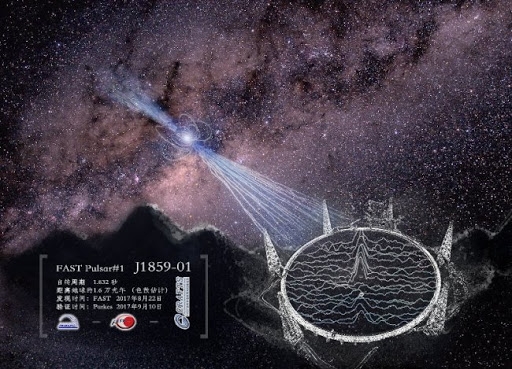China Sky Eye - Biggest Radio Telescope in the World
 |
| Photo: Business Insider |
Where is the exact location of FAST?
Also known as Tianyan, or the Eye of Heaven, The Five-hundred-meter Aperture Spherical Radio Telescope (FAST) is the world’s largest single-dish telescope, situated in a karst depression in Pingtang, Guizhou province in southwest China. Nearby settlements were relocated to reduce electromagnetic emissions which could interfere with the telescope’s sensitive operations. It appears to be a giant golf ball in the middle of China’s new Pingtang Astronomy Town.
FAST HAS BEEN in the making for a long time. In the early 2000s, China angled to host the Square Kilometre Array, a collection of coordinated radio antennas whose dishes would be scattered over thousands of miles. But in 2006, the international SKA committee dismissed China, and then chose to set up its distributed mondo-telescope in South Africa and Australia instead, as shows skyandtelescope.
How does it look like?
As you got closer, you'll see a red carpet unrolled into the entrance of the giant white orb, guarded by iridescent dragons on an inflatable arch. Inside, they buckled up in rows of molded yellow plastic chairs. The lights dimmed. It was an IMAX movie—a cartoon, with an animated narrator.
It was a clip-art version of the gargantuan telescope itself. Small cartoon FAST flew around big cartoon FAST, describing the monumental feat of engineering just over yonder: a giant geodesic dome shaped out of 4,450 triangular panels, above which receivers collect radio waves from astronomical objects.
Budget for building FAST
China spent $180 million to create the telescope, which officials have repeatedly said will make the country the global leader in radio astronomy. But the local government also spent several times that on this nearby Astronomy Town—hotels, housing, a vineyard, a museum, a playground, classy restaurants, all those themed light fixtures. The government hopes that promoting their scope in this way will encourage tourists and new residents to gravitate to the historically poor Guizhou province.
Astronomy town
FAST’s site used to be remote like that. The country even forcibly relocated thousands of villagers who lived nearby, so their modern trappings wouldn’t interfere with the new prized instrument.
But then, paradoxically, the government built—just a few miles from the displaced villagers’ demolished houses—this astronomy town. It also plans to increase the permanent population by hundreds of thousands. That’s a lot of cell phones, each of which persistently emits radio waves with around 1 watt of power, cites wired.
 |
| FAST's spectacular ability to find pulsars (Photo: China Plus) |
Fast Facts About 500m Diameter Radio Telescope!
The FAST has what is known as a fixed primary reflector dish (to receive radio signals) and its location was chosen partly on the basis of the natural depression amongst the beautiful limestone Karst formations.
Unfortunately, a village of farmers already occupied the depression so had to be relocated along with another 9,000+ people that surrounded the telescope so that a radio-quiet zone could be established.
More than $270 million was spent on relocating these residents, which ended up being significantly more than the building cost of the telescope itself at only $180 million.
The construction of the telescope's dish started in 2011, with the last of the 4450 perforated aluminum panels installed five years later in 2016. Each panel can be deformed (to assist alignment to the targets in the sky) so is considered an active surface.
Although the reflector dish is 500 meters (1,600 ft) in size, due to its non-spherical shape and the way it swivels to focus on different portions of the celestial sphere, only an effective dish of 300 m in diameter is utilized.
When the maximum target angle from the zenith (directly overhead) approaches 60 degrees, the effective dish size is reduced further to only 200m
The FAST observes at wavelengths of 10 cm to 4.3 m and working frequency range of 70 MHz to 3.0 GHz.
The telescope began operating in late 2016 and made its first discovery of two new pulsars in August 2017.
Several of the major science objectives of the FAST radio telescope is to observe pulsars (radio-emitting stars), detection of interstellar molecules and attempt to detecting interstellar intelligent communication signals (search for extraterrestrial intelligence) if any exist.
The FAST is similar to the existing Arecibo Observatory radio telescope in Puerto Rico, but has a wider field of view (and collection area) even though Arecibo can receive higher frequencies and is even capable of radar astronomy to image small near-Earth Objects!
| According to nature, Identifying a planet in FAST’s wide beam is a challenge, because they are so faint and small. But Li’s team wants to boost the telescope’s performance by adding 36 dishes, each 5 metres wide. Although the dishes are relatively cheap, off-the-shelf products, together they will improve FAST’s spatial resolution by 100 times, he says. |
 99 Most Fascinating Facts about the World you may never Know 99 Most Fascinating Facts about the World you may never Know |
 Severn Bridge - the First iron Bridge ever built in the World Severn Bridge - the First iron Bridge ever built in the World |
 What is the First Railway in the World? What is the First Railway in the World? |























